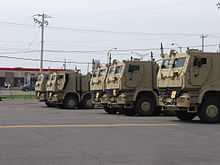CFB Valcartier
| Valcartier (W/C J.H.L. (Joe) Lecomte) Heliport CFB Valcartier Base des Forces canadiennes Valcartier | |||
|---|---|---|---|
 | |||
| Actros Armoured Heavy Support Vehicle System trucks in Valcartier | |||
| IATA: YOY – ICAO: CYOY | |||
| Summary | |||
| Airport type | Military | ||
| Owner | Government of Canada | ||
| Operator | DND | ||
| Location | Saint-Gabriel-de-Valcartier, Quebec | ||
| Built | 1914 | ||
| Commander | Colonel Jean-Marc Lanthier | ||
| Occupants | 5 CMBG | ||
| Time zone | EST (UTC−05:00) | ||
| • Summer (DST) | EDT (UTC−04:00) | ||
| Elevation AMSL | 550 ft / 168 m | ||
| Coordinates | 46°54′10″N 071°30′13″W / 46.90278°N 71.50361°W | ||
| Website | |||
| Map | |||
 CYOY | |||
| Helipads | |||
| Number | Length | Surface | |
| ft | m | ||
| 1 | 150 | 46 | n/a |
| Source: Canada Flight Supplement[1] | |||

Canadian Forces Base Valcartier is a Canadian Forces Base located in the municipality of Saint-Gabriel-de-Valcartier, approximately 25 km (16 mi) north of Quebec City. It is home to 5 Canadian Mechanized Brigade Group.
Origins

CFB Valcartier was originally erected as a military training camp in August 1914 as part of the mobilization of the Canadian Expeditionary Force at the onset of World War I.[2] A 10-foot-6-inch (3.20 m)-high bronze figure of a World War I soldier (1995) by André Gauthier (sculptor) at the entrance to CFB Valcartier commemorates the training of Canadian Army volunteers for the European battlefields in World War I.
The site was also used as an internment camp for "enemy aliens", mainly eastern Europeans. The name Valcartier comes from the town of Saint-Gabriel-de-Valcartier, of which a large section was expropriated in order to create the military training camp.[3] Due to its proximity to the Port of Quebec, Valcartier became the largest military camp on Canadian soil, including some 32,000 men and 8,000 horses.[4]
In 1968, after unification of the Canadian Forces, the title 5 Canadian Mechanized Brigade Group was assigned to the brigade group established in CFB Valcartier.
Military presence

Currently, Valcartier Garrison is home to 5 Canadian Mechanized Brigade Group.
The following units are stationed at Valcartier:
- Headquarters and Signals Squadron (Quartier général et escadron de transmissions)
- 5e Régiment d'artillerie légère du Canada
- 12e Régiment blindé du Canada (12 RBC)
- 5 Combat Engineer Regiment (5e Régiment du génie de combat)
- 1st Battalion, Royal 22e Régiment
- 2nd Battalion, Royal 22e Régiment
- 3rd Battalion, Royal 22e Régiment
- 5 Service Battalion (5e Bataillon des services du Canada)
- 5 Military Police Platoon (5e Peloton de police militaire)
- 5 Field Ambulance (5e Ambulance de campagne)

The base also houses 430 Tactical Helicopter Squadron, 5 Service Battalion (which also provides services from ASU Saint-Jean and CFB Montreal), CI SQFT (Land Force Quebec Area Training Centre), in addition to providing training facilities for most Quebec-based reserve units. The Myriam Bédard Biathlon Training Centre is also located on the base.[5]
CFB Valcartier is also home to a Defence Research and Development Canada (DRDC) location, which conducts military research for the Canadian Forces.
Cadets

ASU Valcartier is also home of the Army Cadet Summer Training Centre Valcartier, which trains Royal Canadian Army Cadets of the Eastern Region / Province of Quebec.
In July 1974, an explosives safety training accident involving "D" Company killed six cadets and injured over 50. A coroners inquiry found the instructor criminally responsible.[6] An account of the explosion, its cause and effects are detailed in the book "As You Were: The Tragedy at Valcartier" by Gerry Fostaty[7] and published by Goose Lane Editions.[8]
Contaminated water
In 1997 a cancer-causing chemical, trichloroethylene, was found in the water supply of CFB Valcartier and the nearby town of Shannon, Quebec. Trichloroethylene, which has been linked to liver cancer, was used for degreasing metal parts at the base in the 1970s. The Department of National Defence, which was accused of a cover-up, reached a legal settlement with the town in 2004.[9][10][11]
References
| Wikimedia Commons has media related to CFB Valcartier. |
- ↑ Canada Flight Supplement. Effective 0901Z 12 December 2013 to 0901Z 6 February 2014
- ↑ History of 5 CMBG
- ↑ A History of Valcartier, Quebec
- ↑ Mobilization of the 1st Canadian Division
- ↑ 5 Canadian Service Battalion
- ↑ Coroner's inquest found 'a climate of negligence'
- ↑ http://www.gerryfostaty.com/
- ↑ http://www.gooselane.com/book/9780864926487
- ↑ Cancer-causing chemical contaminates Quebec town's water
- ↑ The Canadian Army
- ↑ CBC News- the fifth estate- Shannon's TCE Water Woes
Coordinates: 46°53′35″N 071°29′35″W / 46.89306°N 71.49306°W